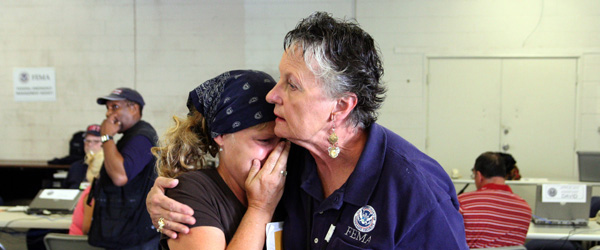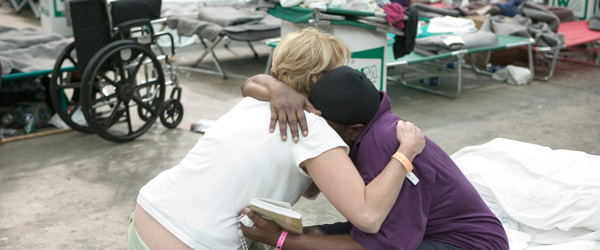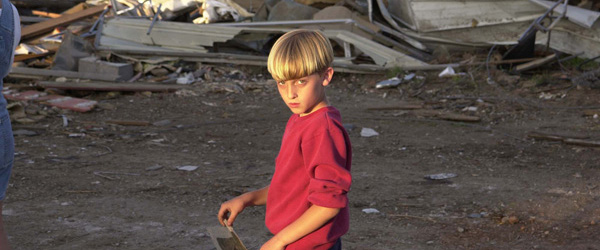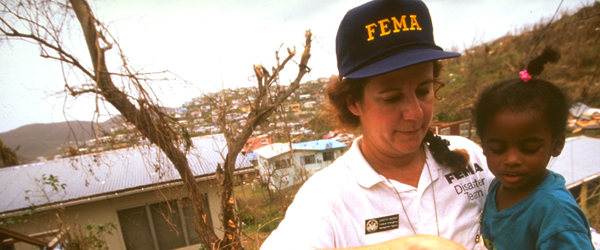Understand the Event
Recognize Signs
Ease Stress
Help Kids Cope
Reassure Children
Disasters are upsetting experiences for everyone involved. The emotional toll that disaster brings can sometimes be even more devastating than the financial strains of damage and loss of home, business or personal property.
Children, senior citizens, people with access or functional needs, and people for whom English is not their first language are especially at risk. Children may become afraid and some elderly people may seem disoriented at first. People with access or functional needs may require additional assistance.
Seek crisis counseling if you or someone in your family is experiencing issues with disaster-related stress.
Understand Disaster Events

Understand the individual effects of a disaster.
- Everyone who sees or experiences a disaster is affected by it in some way.
- It is normal to feel anxious about your own safety and that of your family and close friends.
- Profound sadness, grief and anger are normal reactions to an abnormal event.
- Acknowledging your feelings helps you recover.
- Focusing on your strengths and abilities helps you heal.
- Accepting help from community programs and resources is healthy.
- Everyone has different needs and different ways of coping.
- It is common to want to strike back at people who have caused great pain.
Children and older adults are of special concern in the aftermath of disasters. Even individuals who experience a disaster “second hand” through exposure to extensive media coverage can be affected.
Contact local faith-based organizations, voluntary agencies, or professional counselors for counseling. Additionally, FEMA and state and local governments of the affected area may provide crisis counseling assistance.
As you recover, it is a good idea to make sure that you have updated your family disaster plan and replenished essential disaster supplies just in case a disaster happens again. You will always feel better knowing that you are prepared and ready for anything.Signs of Disaster-Related Stress
Seek counseling if you or a family member are experiencing disaster-related stress.
Recognize Signs of Disaster-Related Stress
When adults have the following signs, they might need crisis counseling or stress management assistance:
- Difficulty communicating thoughts.
- Difficulty sleeping.
- Difficulty maintaining balance in their lives.
- Low threshold of frustration.
- Increased use of drugs/alcohol.
- Limited attention span.
- Poor work performance.
- Headaches/stomach problems.
- Tunnel vision/muffled hearing.
- Colds or flu-like symptoms.
- Disorientation or confusion.
- Difficulty concentrating.
- Reluctance to leave home.
- Depression, sadness.
- Feelings of hopelessness.
- Mood-swings and easy bouts of crying.
- Overwhelming guilt and self-doubt.
- Fear of crowds, strangers, or being alone.
Easing Stress
 Talk to someone and seek professional help for disaster-related stress.
Talk to someone and seek professional help for disaster-related stress.
The following are ways to ease disaster-related stress:
- Talk with someone about your feelings - anger, sorrow and other emotions - even though it may be difficult.
- Seek help from professional counselors who deal with post-disaster stress.
- Do not hold yourself responsible for the disastrous event or be frustrated because you feel you cannot help directly in the rescue work.
- Take steps to promote your own physical and emotional healing by healthy eating, rest, exercise, relaxation and meditation.
- Maintain a normal family and daily routine, limiting demanding responsibilities on yourself and your family.
- Spend time with family and friends.
- Participate in memorials.
- Use existing support groups of family, friends and religious institutions.
Ensure you are ready for future events by restocking your disaster supplies kits and updating your family disaster plan. Doing these positive actions can be comforting.

Are you experiencing distress or other mental health concerns related to natural or human-caused disasters? Visit the Disaster Distress Helpline.
Helping Kids Cope with Disaster

Disasters can leave children feeling frightened, confused, and insecure. Whether a child has personally experienced trauma, has merely seen the event on television or has heard it discussed by adults, it is important for parents and teachers to be informed and ready to help if reactions to stress begin to occur.
Children may respond to disaster by demonstrating fears, sadness or behavioral problems. Younger children may return to earlier behavior patterns, such as bedwetting, sleep problems and separation anxiety. Older children may also display anger, aggression, school problems or withdrawal. Some children who have only indirect contact with the disaster but witness it on television may develop distress.
Recognize Risk Factors
For many children, reactions to disasters are brief and represent normal reactions to "abnormal events." A smaller number of children can be at risk for more enduring psychological distress as a function of three major risk factors:
- Direct exposure to the disaster, such as being evacuated, observing injuries or death of others, or experiencing injury along with fearing one’s life is in danger.
- Loss/grief: This relates to the death or serious injury of family or friends.
- On-going stress from the secondary effects of disaster, such as temporarily living elsewhere, loss of friends and social networks, loss of personal property, parental unemployment, and costs incurred during recovery to return the family to pre-disaster life and living conditions.
Vulnerabilities in Children
In most cases, depending on the risk factors above, distressing responses are temporary. In the absence of severe threat to life, injury, loss of loved ones, or secondary problems such as loss of home, moves, etc., symptoms usually diminish over time. For those that were directly exposed to the disaster, reminders of the disaster such as high winds, smoke, cloudy skies, sirens, or other reminders of the disaster may cause upsetting feelings to return. Having a prior history of some type of traumatic event or severe stress may contribute to these feelings.
Children’s coping with disaster or emergencies is often tied to the way parents cope. They can detect adults’ fears and sadness. Parents and adults can make disasters less traumatic for children by taking steps to manage their own feelings and plans for coping. Parents are almost always the best source of support for children in disasters. One way to establish a sense of control and to build confidence in children before a disaster is to engage and involve them in preparing a family disaster plan. After a disaster, children can contribute to a family recovery plan.
Meeting the Child’s Emotional Needs
Children’s reactions are influenced by the behavior, thoughts, and feelings of adults. Adults should encourage children and adolescents to share their thoughts and feelings about the incident. Clarify misunderstandings about risk and danger by listening to children’s concerns and answering questions. Maintain a sense of calm by validating children’s concerns and perceptions and with discussion of concrete plans for safety.
Listen to what the child is saying. If a young child is asking questions about the event, answer them simply without the elaboration needed for an older child or adult. Some children are comforted by knowing more or less information than others; decide what level of information your particular child needs. If a child has difficulty expressing feelings, allow the child to draw a picture or tell a story of what happened.
Try to understand what is causing anxieties and fears. Be aware that following a disaster, children are most afraid that:
- The event will happen again.
- Someone close to them will be killed or injured.
- They will be left alone or separated from the family.
Reassuring Children After a Disaster

Suggestions to help reassure children include the following:
- Personal contact is reassuring. Hug and touch your children.
- Calmly provide factual information about the recent disaster and current plans for insuring their safety along with recovery plans.
- Encourage your children to talk about their feelings.
- Spend extra time with your children such as at bedtime.
- Re-establish your daily routine for work, school, play, meals, and rest.
- Involve your children by giving them specific chores to help them feel they are helping to restore family and community life.
- Praise and recognize responsible behavior.
- Understand that your children will have a range of reactions to disasters.
- Encourage your children to help update your a family disaster plan.
If you have tried to create a reassuring environment by following the steps above, but your child continues to exhibit stress, if the reactions worsen over time, or if they cause interference with daily behavior at school, at home, or with other relationships, it may be appropriate to talk to a professional. You can get professional help from the child’s primary care physician, a mental health provider specializing in children’s needs, or a member of the clergy.
Monitor and Limit Exposure to the Media
News coverage related to a disaster may elicit fear and confusion and arouse anxiety in children. This is particularly true for large-scale disasters or a terrorist event where significant property damage and loss of life has occurred. Particularly for younger children, repeated images of an event may cause them to believe the event is recurring over and over.
If parents allow children to watch television or use the Internet where images or news about the disaster are shown, parents should be with them to encourage communication and provide explanations. This may also include parent’s monitoring and appropriately limiting their own exposure to anxiety-provoking information.
Use Support Networks
Parents help their children when they take steps to understand and manage their own feelings and ways of coping. They can do this by building and using social support systems of family, friends, community organizations and agencies, faith-based institutions, or other resources that work for that family. Parents can build their own unique social support systems so that in an emergency situation or when a disaster strikes, they can be supported and helped to manage their reactions. As a result, parents will be more available to their children and better able to support them. Parents are almost always the best source of support for children in difficult times. But to support their children, parents need to attend to their own needs and have a plan for their own support.
Preparing for disaster helps everyone in the family accept the fact that disasters do happen, and provides an opportunity to identify and collect the resources needed to meet basic needs after disaster. Preparation helps; when people feel prepared, they cope better and so do children.
A Child’s Reaction to Disaster by Age
Below are common reactions in children after a disaster or traumatic event.
Birth through 2 years. When children are pre-verbal and experience a trauma, they do not have the words to describe the event or their feelings. However, they can retain memories of particular sights, sounds, or smells. Infants may react to trauma by being irritable, crying more than usual, or wanting to be held and cuddled. The biggest influence on children of this age is how their parents cope. As children get older, their play may involve acting out elements of the traumatic event that occurred several years in the past and was seemingly forgotten.
Preschool - 3 through 6 years. Preschool children often feel helpless and powerless in the face of an overwhelming event. Because of their age and small size, they lack the ability to protect themselves or others. As a result, they feel intense fear and insecurity about being separated from caregivers. Preschoolers cannot grasp the concept of permanent loss. They can see consequences as being reversible or permanent. In the weeks following a traumatic event, preschoolers’ play activities may reenact the incident or the disaster over and over again.
School age - 7 through 10 years. The school-age child has the ability to understand the permanence of loss. Some children become intensely preoccupied with the details of a traumatic event and want to talk about it continually. This preoccupation can interfere with the child’s concentration at school and academic performance may decline. At school, children may hear inaccurate information from peers. They may display a wide range of reactions — sadness, generalized fear, or specific fears of the disaster happening again, guilt over action or inaction during the disaster, anger that the event was not prevented, or fantasies of playing rescuer.
Pre-adolescence to adolescence - 11 through 18 years. As children grow older, they develop a more sophisticated understanding of the disaster event. Their responses are more similar to adults. Teenagers may become involved in dangerous, risk-taking behaviors, such as reckless driving, or alcohol or drug use. Others can become fearful of leaving home and avoid previous levels of activities. Much of adolescence is focused on moving out into the world. After a trauma, the view of the world can seem more dangerous and unsafe. A teenager may feel overwhelmed by intense emotions and yet feel unable to discuss them with others.

